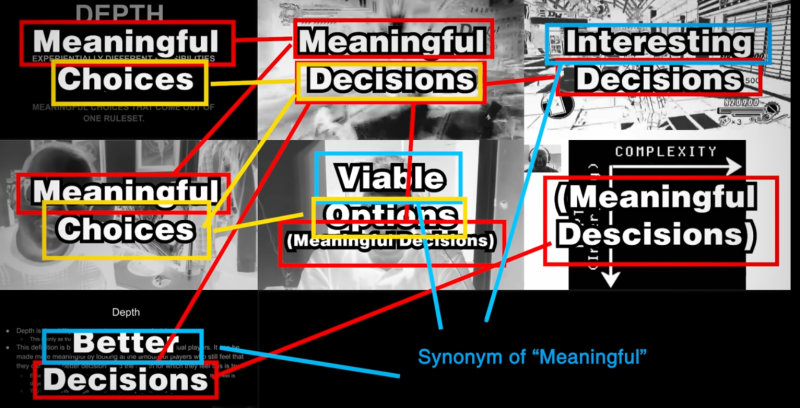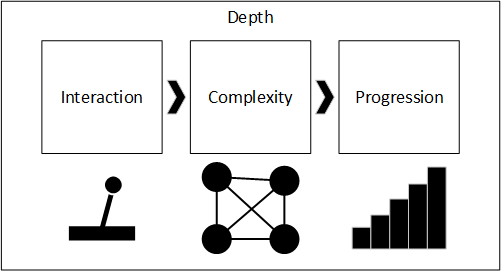Developing games with depth
Since my website layout is mostly complete now, it’s time to make use of it. In the coming years, my aim is to regularly release blog posts about gamedev topics. Let’s start with games and depth.
The reason I’ve been thinking about the topic of “depth” in games is because I recently played Space Haven - An isometric, top-down sci-fi management game, where you control a bunch of people inhabitating a space ship. In the game, you can construct the ship, and you also have to make sure certain needs are met. For example, you don’t want your people to become cold or suffocate because you failed your temperature management or oxygen production.
The game is released in early-access, and after playing around three hours of it, I felt that something is missing. This feeling is familar to most people who want more of their games. Nothing in the game really grabs you, and so nothing makes you enjoy hundreds of hours on that single game.
As someone who wants to develop games, the question is: How do you ensure that your game doesn’t remain shallow, and makes people want to play more of it? How do you generate “depth”? What is even meant by it? I aim to answer those questions in this post.
Disclaimer: I still have a lot to learn in game development, and I haven’t released a game yet. This post is also for me to look back to, and hopefully find some lessons learned.

So what is depth? I am sure most of us know games with apparent depth in them, like the classic Dwarf Fortress or the modern reinterpretation of it, Rimworld. On the other hand, people are also aware of games that struggle to generate depth, like the Assassin’s Creed series. Those games are often perceived as “shallow” - the opposite of depth.
This still doesn’t explain what we mean by it, and of course there are multiple interpretations for depth. For some, no depth may simply be the lack of meaningful choices, while for others it might be missing interactions in the game world.
If we go back to the Space Haven example, I felt like that the game did not provide enough progression to work towards, at least with the first early access version of it. Even worse for me, it offered a map where you had a base from the beginning and had to build your own ship.
This sounds fun in theory, but it also meant that the base included nearly everything the game had to offer in buildable objects. More technologically sophisticated resources were already required and avaialble from the start, so it was simply a matter of building everything that you had access to, with little thought behind it. (Of course, this doesn’t mean Space Haven is a bad game, quite the opposite of it. Despite being early access, it is quite stable, and the devs are also communicative.)
How is depth defined by others?
When quickly searching the internet for topics regarding this topic, I found five potential sources for explaining depth.
Let’s start with the most popular one, the Extra Credit’s video (which has currently over 600.000 views). They use a very simple definition of depth:
Number of emergent experientially different possibilites or meaningful choices that come out of one ruleset.
They see depth as an entirely mental activity not to be confused with complexity, a term we will hear more often when discussing depth. Similarly, “emergent” is a popular buzzword when discussing depth, just like “meaningful choices”.
A similar approach is taken in Josh Bycer’s blog post who defines it as
The number of viable options at any given moment while playing a video game.
Again, there is a lack of explanation on what is viable, and also if a game with just one viable option automatically has less depth than a game with say three viable options.
This point is also brought up by Tynan Sylvester in a lengthy discussion on a Gamasutra article by Lewis Pulsipher. Acorrding to Tynan, rock-paper-scissors doesn’t become deeper just because we add two more options to it so you have five possible choices. Instead, a game’s depth can be measured for example by checking the skill of the player after their performance stops improving.
A lengthy video by Turbo Button sees depth generally as
the ability of a player making meaningful decisions relating to core machines of the game.
He complements this definition by arguing that deep games have a divide between low and high skill players, that there is a large possibility space which allows for experimentation, and that depth comes with difficulty, e.g. when the player has to engage in difficult decisions. He makes an interesting point with upgrade trees: They are often used to imply depth, but offer no improvement of the core gameplay, or worse, make core gameplay worse.
As a side note, Turbo Button argues that puzzle games have no evolving depth since there is often only one solution. An answer to this problem is to design puzzle games “Zach-Like” (like Opus Magnum), where they represent more a set of rules which allows multiple solutions with different efficiencies.
Finally, we have and even longer video by Veselekov’s video, who models depth around the idea of inside depth, outside depth and directoy depth, which comes pretty close to the model I had in mind. He references a variety of other sources, and notices that most of them use that definition, as seen in the picture below. Similar to me, he sees the definition using “meaningful decisions” as inadequate, since “meaningful” is inherently subjective.

With Veselekov’s model, depth is more than just having choices. Inside depth basically corresponds to the agency of the player, i.e. learning that happens inside the players and are actions executed with the controller. Outside depth are mechanics the player doesn’t have access to, but still has to learn, like tactics, level design, or how the artifical intelligence works in games. Finally, there is directory depth, which orchestrates inside and outside depth so they explain why the mechanics exist in the first place. Overall, depth is defined by him as
an emotional spectrum of intimate learning.
How do I see depth?
Generally, all the definitions shown above have some truth in them. Of course people first associate deeper games with “meaningful” decisions, so it’s no wonder they see it that way. Overall, I am mostly convinced by Veselekov’s argument, since he goes into detail on how to differentiate types of depth to build his definition. This should make it easier for game developers to better understand and create depth in their games.
I personally would improve on the definition by using terms often associated with depth, that make it clear what is meant with inside, outside and directory depth. Let’s start with the first prerequisite to even create depth in the first place: it needs interaction, so we can count it as a game. Of course we can think of complex, deep simulations that require no interaction of the player at all. Games hardly count as deep when you cannot interact with the mechanics. Therefore, the game needs interaction to create depth, and the possibilites of interaction result in the aforementioned inside depth.
Furthermore, deep games mostly work with complexity. However, it is important to define complexity too, and I see it differently to Extra Credit’s approach, who describe complexity as the mental burden on the player. Instead, I will use my social networks background for it, since complexity does not necessarily result in a mental burden - do not confuse it with something being complicated or something just having a lot of breadth. Many games inherently represent complex systems, and there is a wonderful article by Ottino who describes the hallmarks of those complex systems:
- Adaption: systems are capable of adapting to changes in the enviornment. As an example in games, the artifical intelligence is capable of reacting to changes induced by the player. Games with in-game economies represent this point very well - if a demand for a good increases, the city could rev up the production of it.
- Self-Organization: systems work without a general top-down instance/authority for controlling them. In the cities example, they are capable of automatically setting their prices for goods, depending on other entities and events in the game.
- Emergence: the interaction of various elements result in new functions that weren’t strictly implemented in the first place - or in other words, the whole is more than the sum of its parts. Continuing the previous example, since entities organize themselves, we can influence them as a player, for example, by buying all the goods and therefore decreasing the supply and increasing the price. Therefore, we have new strategies we can use to impact the (game) system.
Following Veselekov, the complexity would mostly include outside depth, and the interaction together with complexity is determined by the directory depth.
Finally, I argue that interaction and complexity is not always enough to create a deep game, at least in the mid-term. At some point, the player will figure out optimal ways to play the game, and have seen everything. To make a truly deep and engaging game, you also want progression in some form. Interacting with the complex world should progress the game in some form, which in turn results in changes to the world, and changes how the game is played. As an example, in Binding of Isaac the player can unlock new items as he progresses through the game. Using these items in future runs creates new synergies and interactions that haven’t been available before.

To summarize my thoughts on depth, I see it as a combination of interaction, complexity and progression. Of course, game developers have to decide for themselves what they want to use to construct their depth - if at all.
Further notes on depth
I feel I have to add two further notes regarding this discussion:
- Every game genre can have a lack of depth.
- A game doesn’t need depth to be enjoyable (or engaging).
The first point is pretty straightforward: each genre we can think of can be simplified enough to not offer any depth whatsover - where there is no player involvement at all.
The second point is not quite as easy. It’s pretty obvious that games exist that are enjoyable to us without offering much depth. A famous example for this is cookie clicker, which I always find an interesting example for game development. After all, in cookie clicker you don’t do much besides clicking, and the majority of that on a single object. Still, we can play it for hours. At some point, we might even not click anymore, because we have automated everything so much that the cookie is clicked by all the upgrades we bought. It’s a simple matter of collecting as much as possible. Still, the game is engaging for quite a while before the player becomes bored, despite the apparent lack of depth.
I hope I can use the discussion here for my game development projects in the future. My aim is to come back to this article later when I have gained more experience, to see if my thought are correct, or if I can further improve my thoughts on it.